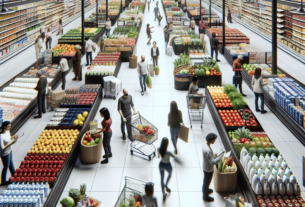Introduction
The grocery retail industry is a vital part of the global economy, providing essential goods to consumers around the world. In recent years, the industry has faced significant challenges due to supply chain disruptions caused by various factors such as natural disasters, labor shortages, and geopolitical issues. In this report, we will explore how grocery retail companies are managing these supply chain disruptions and adapting to the changing landscape of the industry.
Current State of the Grocery Retail Industry
According to a recent report by CulinaryCoverage.com, the global grocery retail industry is expected to reach a market value of $12 trillion by 2025. The industry is highly competitive, with a few major players dominating the market. Some of the largest grocery retail companies include Walmart, Amazon, and Kroger.
Market Share
Walmart is currently the largest grocery retailer in the world, with a market share of over 10%. The company operates over 11,000 stores worldwide and has a strong presence in both the United States and international markets. Amazon, on the other hand, has been rapidly expanding its grocery business through its acquisition of Whole Foods Market and the launch of Amazon Fresh. Kroger is another major player in the industry, with a market share of around 7%.
Financial Performance
In terms of financial performance, Walmart reported revenues of $560 billion in 2024, making it the largest grocery retailer by revenue. Amazon reported revenues of $400 billion, while Kroger reported revenues of $130 billion. Despite the challenges posed by supply chain disruptions, these companies have continued to grow and expand their operations.
Challenges Faced by Grocery Retail Companies
The grocery retail industry faces a number of challenges when it comes to managing supply chain disruptions. Some of the key challenges include:
Natural Disasters
Natural disasters such as hurricanes, earthquakes, and floods can have a significant impact on the supply chain of grocery retail companies. These disasters can disrupt transportation networks, damage infrastructure, and lead to shortages of essential goods. For example, Hurricane Katrina in 2005 caused widespread damage to grocery stores in the affected areas, leading to food shortages and price increases.
Labor Shortages
Labor shortages are another major challenge faced by grocery retail companies. The industry relies heavily on a large workforce to stock shelves, operate checkout counters, and fulfill online orders. However, labor shortages can make it difficult for companies to meet customer demand and maintain efficient operations. For example, the COVID-19 pandemic led to a shortage of workers in grocery stores, causing delays in restocking shelves and processing orders.
Geopolitical Issues
Geopolitical issues such as trade wars, sanctions, and political instability can also disrupt the supply chain of grocery retail companies. These issues can lead to disruptions in the transportation of goods, higher import costs, and trade restrictions. For example, the trade war between the United States and China has resulted in higher tariffs on imported goods, affecting the cost and availability of certain products in grocery stores.
Strategies for Managing Supply Chain Disruptions
Grocery retail companies have implemented a variety of strategies to manage supply chain disruptions and mitigate their impact on operations. Some of the key strategies include:
Diversifying Suppliers
One of the most effective ways to manage supply chain disruptions is to diversify suppliers and sources of raw materials. By working with multiple suppliers, grocery retail companies can reduce their reliance on a single source and minimize the risk of shortages. For example, Walmart has a network of thousands of suppliers around the world, allowing the company to quickly adjust its supply chain in response to disruptions.
Investing in Technology
Investing in technology is another key strategy for managing supply chain disruptions. Grocery retail companies are increasingly using advanced technologies such as artificial intelligence, blockchain, and data analytics to improve the efficiency and resilience of their supply chains. For example, Amazon uses AI-powered algorithms to forecast demand and optimize inventory levels, helping the company to reduce stockouts and minimize waste.
Collaborating with Partners
Collaborating with partners such as logistics providers, suppliers, and other retailers is essential for managing supply chain disruptions. By working together, companies can share information, resources, and best practices to improve the resilience of their supply chains. For example, Kroger has formed partnerships with local farmers and producers to ensure a stable supply of fresh produce to its stores.
Future Outlook for the Grocery Retail Industry
Despite the challenges posed by supply chain disruptions, the future outlook for the grocery retail industry remains positive. As consumer demand for convenience, sustainability, and transparency continues to grow, grocery retail companies will need to innovate and adapt to meet these evolving needs. By leveraging technology, diversifying suppliers, and collaborating with partners, companies can position themselves for success in the rapidly changing landscape of the industry.
In conclusion, the grocery retail industry is facing significant challenges when it comes to managing supply chain disruptions. However, companies have implemented various strategies to mitigate these challenges and ensure the efficient operation of their supply chains. By diversifying suppliers, investing in technology, and collaborating with partners, grocery retail companies can navigate the complexities of the industry and continue to meet the needs of consumers around the world.



